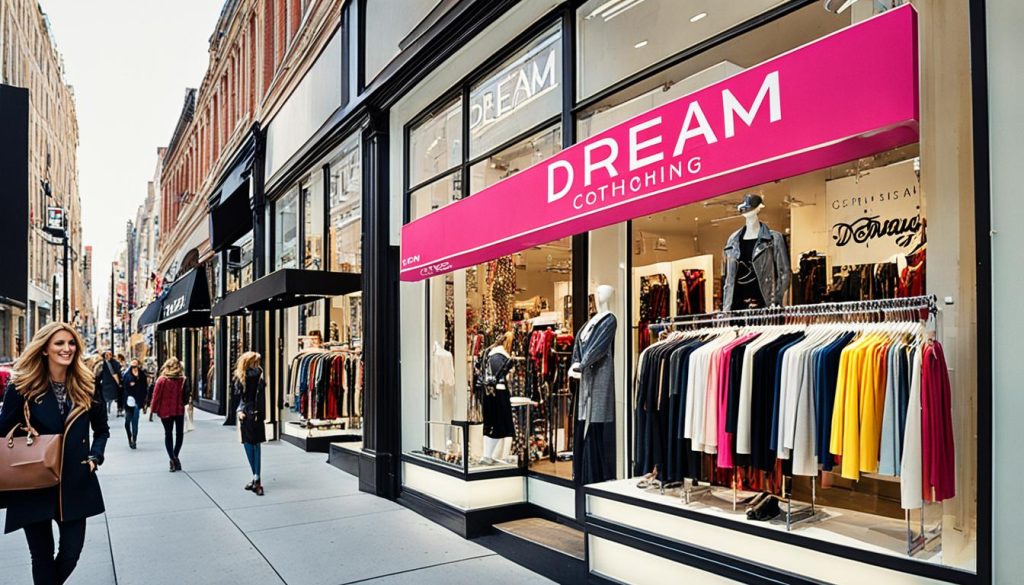Starting a clothing boutique is a thrilling way to enter the fashion retail world. The UK boutique market, worth nearly £55 billion in 2022, is full of opportunities. A boutique offers a unique and personal shopping experience with special fashion choices.
To begin, you need to know the latest fashion trends and what customers like. Selling items from novelty socks to prom dresses requires the ability to change your sales strategies. This might include selling online, in physical shops, or through social media. This flexibility helps your boutique grow in the competitive UK market.
Success in fashion retail means focusing on key areas. You must keep up with trends, manage stock well, provide excellent customer service, and follow the law. With careful planning, your boutique can standout in the UK’s busy clothing industry. You can make your dream boutique successful.
What is a Clothing Boutique Business?
A clothing boutique is special in the retail world. It’s different from big chain stores because it offers a more personal fashion service. This makes it a favourite place for people who love style.
Definition and Characteristics
A clothing boutique is a small retail shop owned by a person or a family. It is known for its special selection of clothes. Boutiques are great because they give personal fashion advice, making shopping there meaningful.
Boutiques have a range of clothes, from fancy outfits to daily wear. They pick each item carefully to match the shop’s unique style. The shop’s atmosphere is friendly and inviting, making customers want to discover all the special items.
Types of Clothing to Sell
The clothes a boutique sells depend on its theme and the customers it wants to attract. You might find beautiful dresses, smart suits, trendy trousers, and lots of accessories. Each piece is chosen with care to keep the boutique’s own style.
The secret to a boutique’s success is offering clothes that match what its customers want. This unique approach sets boutiques apart from big stores. It offers a shopping experience that’s both personal and full of style.
Understanding Your Niche
Starting a clothing boutique means you need to find a special fashion area and understand what your customers want. This involves a lot of research and planning. It’s important to ensure your shop meets customer needs and stands out from the competition.
Choosing Your Fashion Focus
Deciding on your boutique’s fashion style is key. You might focus on formalwear, sporty clothes, or unique items. Think about what’s popular, what clothes people want in different seasons, and the look you want for your shop. This helps attract customers who like your style.
Assessing Market Demand
After picking your style, it’s time to see if people want it. Understanding current trends and what your customers like is important. Consider quality, how much to charge, and if there are similar shops around. Talking to potential customers through surveys or on social media can give you great ideas. This helps make your shop more appealing and successful.
Identifying Your Target Audience
Finding out who will buy your clothes is key for any boutique’s success. Knowing your customers and their needs helps shape your marketing and products. You need to look closely at who they are and what they like. This means checking out their age, what they’re into, and other details.
Demographics and Psychographics
Demographics are facts about your potential buyers like their age, gender, how much they earn, and their education. For example, a boutique near a university might focus on students. This means they’re probably younger and don’t spend too much. Psychographics go deeper into your target market’s lifestyle, values, and personality. If they care about the planet, you might stock green products and highlight your ethical sources.
Creating Customer Personas
Creating detailed buyer personas can really pin down your strategy. These personas are made-up but based on real research and data. They show things like how your ideal customers shop, what they wear, and what they watch or read. For instance, you might have ‘Eco-conscious Emma’ who loves green brands and follows eco-friendly influencers. Knowing this, you’d stock things she likes and create social media ads that speak to her.
In conclusion, really understanding who wants to buy your clothes and who they are is vital. This approach lets you make smart choices about what to sell, what materials to use, and how to market. That way, you attract and keep the customers you want.
Write a Comprehensive Business Plan
Making a detailed plan for a clothing boutique is vital for its future success. This plan outlines your business goals. It also shows how you will manage finances to support and expand your business.
Elements of a Successful Plan
Your business plan should cover several important areas:
- Niche Identification: Clearly outline the unique fashion segment your boutique will focus on.
- Target Audience: Define your ideal customers, their preferences, and how you will attract and retain them.
- Competitive Analysis: Assess other boutiques in your market to understand their strengths and weaknesses.
- Legal Structure: Decide on the legal form of your business and ensure compliance with all regulations.
- Financing Strategy: Plan how you will fund the start-up and ongoing costs of the boutique.
- Location: Choose an optimal location that aligns with your target demographic.
- Marketing Approach: Develop a comprehensive marketing strategy to promote your brand and attract customers.
Financial Projections and Plans
Financial planning is key in your business plan for a clothing boutique. You should include:
- Start-Up Costs: Detailed estimates for initial expenses such as inventory, store setup, and marketing.
- Revenue Forecasts: Projections based on market research and anticipated sales.
- Expense Management: Strategies for controlling costs while maintaining quality and service standards.
- Profit Margins: Analysis of pricing strategies to ensure profitable margins on all products.
- Cash Flow Management: Plans to monitor and manage cash flow to maintain financial stability.
By linking clear goals with thorough financial planning, your business plan will be a strong guide. It will help launch and grow a successful clothing boutique.
Legal Structure and Registration
When starting a clothing boutique, choosing the right legal structure is vital. It affects obligations, tax schemes, and financial risks.
Sole Trader vs Limited Company
Being a sole trader means you control and are fully responsible for all debts. This option is straightforward, so many small businesses prefer it. On the other hand, a limited company provides limited liability. This protects your personal assets if the company owes money. It’s important to consider both options carefully, thinking about what each means for you and your business dreams.
Required Registrations and Licences
To operate legally, getting the right registrations and licences for your clothing boutique is crucial. Start with registering at Companies House. You must get a tax identification number and follow any regulations specific to your industry. Furthermore, you might need special licences, especially for selling imported goods or unique items. Knowing and complying with legal requirements is essential to avoid fines and ensure your business runs smoothly.
Financing Your Clothing Boutique
Launching your dream clothing boutique means understanding start-up costs and funding options. Knowing financial needs ensures your boutique starts strong. This makes the journey towards success smoother.
Start-Up Costs
First, calculate all initial costs for your boutique. This includes buying stock, store decor, marketing materials, and website costs. Knowing these expenses helps plan the needed capital to start your boutique.
Funding Options
Getting the right funding is crucial. Entrepreneurs have many options, each with its benefits and conditions. Using personal savings means you won’t have debt. But, business loans offer more money with a payback plan.
Angel investors provide money and guidance. Crowdfunding uses public support to gather funds. Government-backed Start-Up Loans could be a good choice too, with agreeable terms.
“Successful boutique start-up financing demands a well-rounded approach, combining meticulous cost assessment with strategic funding choices to ensure smooth operations and future expansion.”
Location and Storefront Considerations
Choosing the right location for your dream clothing shop is crucial. A prime spot boosts foot traffic and your shop’s success. Knowing your customers and making sure the location matches their style is vital.
Being near other shops and landmarks makes your boutique even more attractive. It draws more people in.
Choosing the Perfect Spot
It’s not just about a beautiful storefront. Think about how many people walk by and the area’s vibe. A busy street brings in more visitors. Being close to similar stores attracts the right customers.
Finding a balance between a great location and cost is important for your business.
Evaluating Lease Agreements
After choosing a great spot, focus on the lease agreement. It’s essential to understand all the details. Make sure the lease matches your budget and space needs.
It’s wise to get help from a legal expert. They can help with the tricky parts of the agreement, like rent increases and repairs.
Setting Up an Online Clothing Store
Establishing an e-commerce fashion boutique today is crucial. It makes you visible to lots of people. Creating a good online store also makes shopping easy for customers. To do well, you must know how to develop your website. You also need good e-commerce platforms.
Website Development Essentials
Your website’s design is very important. Make sure it is easy to look at and use. It should also work well on phones and computers. Think about getting professional help with your design. Or, you could use tools like Shopify or WooCommerce. They help make beautiful and working websites that attract and keep customers.
Integrating E-Commerce Platforms
Being able to handle sales well is crucial for online shops. You should use e-commerce systems that make things like managing stock and payments easy. Platforms like Magento or BigCommerce help a lot. They aid in showing products, dealing with orders, and taking payments. This makes your shop run smoothly. It gives your customers a good shopping experience.
“The convenience and accessibility of online store development cannot be overstated, especially for a modern e-commerce fashion boutique aiming to thrive in the digital retail space.”
Using these ideas helps your online presence grow. It prepares you for success in the fast-paced fashion market.
Purchasing and Managing Inventory
Effective inventory management is key for clothing boutiques. It makes sure the right items are there when needed. This boosts sales and customer happiness. A key part is having strong ties with suppliers to get quality stock regularly.
Building Relationships with Suppliers
Good relationships with suppliers can bring good deals and unique products. Trade shows and fashion events are great for finding new suppliers. Regular talks and paying on time help strengthen these bonds. This makes your boutique run smoothly.
Merchandise Pricing Strategies
Setting the right prices is important to stay competitive and make a profit. Prices should match what your customers expect and your boutique’s image. Think about costs, how much you want to earn, what competitors charge, and how customers see your value. Frequently check and change prices based on sales and trends to keep your stock right and profits up.
Creating Effective Marketing Strategies
Creating powerful marketing plans is key for any new fashion shop wanting to stand out. A good strategy boosts your brand’s visibility and connects with potential customers.
Social Media Campaigns
Social media is great for promoting fashion brands and talking directly with your audience. Posting about new lines, behind-the-scenes looks, and fashion tips keeps followers interested. Using paid ads and working with influencers can help more people find your boutique.
Hosting Launch Events
Having a launch event can really raise your boutique’s profile. Invite fashion influencers, experts, and loyal customers to a special opening to make a buzz. These events attract new customers and build a community that encourages people to come back and tell others about it. Make sure to share the best moments of the event on your social media.
Store Policies and Customer Service
For a clothing boutique to be successful, clear store policies and good customer service are key. These elements help create great customer experiences. This, in turn, increases customer satisfaction.
Return and Exchange Policies
A well-outlined return and exchange policy is crucial. It reduces misunderstandings and informs customers about their rights. Such a policy makes everyone happy and keeps things running smoothly.
A good return and exchange policy should clearly state:
- The accepted timeframe for returns or exchanges.
- The condition that items must be in for a return or exchange.
- If refunds are in cash or store credit.
- Exceptions like sale items or personalised goods.
Staff Training and Development
Great customer service begins with employee training. Training ensures staff understand the brand and can help customers well.
Training programmes should include:
- Knowledge about products to answer customer questions confidently.
- Customer service skills for handling complaints and offering help.
- Sales techniques for suggesting additional products.
- Understanding of store procedures for smooth operations.
Through ongoing training, employees stay skilled and motivated. This leads to better customer service. Excellent service makes customers come back and boosts the boutique’s image.
Start a Clothing Boutique
Starting a fashion boutique is exciting. It blends creativity with the promise of reward. First, you need to find a niche that matches the market and your fashion vision. This involves doing detailed market research to know what your potential customers want.
Setting up your business legally is vital. You must choose the right legal structure for you. This could be a sole trader, a partnership, or a limited company. Each one has different responsibilities and tax rules. It’s important to follow local laws and get the right licences to operate smoothly.
Financial planning is key when opening a fashion boutique. This means making detailed financial plans, budgeting for start-up costs, and figuring out how to fund your business. Many retail start-ups look at personal savings, business loans, or investor support. Good budgeting helps you handle unexpected costs without trouble.
The location of your boutique is very important. It must suit your target audience and your brand. If you’re opening a physical store, consider the lease terms carefully and make sure it fits your logistical needs.
If you have an online store, it’s like a digital version of your physical shop. Your website should be easy to use. Using good e-commerce platforms helps with smooth customer transactions. Using digital marketing, like social media, will make more people aware of your boutique.
Opening a clothing boutique takes a mix of creativity, careful planning, and business skills. As you turn your fashion dream into reality, you need to stay dedicated. Understanding your niche, setting up shop, and everyday management all require hard work and a clear vision.
Utilising Technology and Tools
Today’s clothing boutiques can thrive by using advanced retail technology tools. Such tools improve operations, inventory management, and customer experience. Using them leads to greater success for your boutique.
POS Systems
A reliable POS system is essential for smooth transactions in a boutique. It offers insights into sales and customer patterns. It keeps an eye on stock, checks employees, and manages customer info. Selecting the right POS system makes shopping efficient and professional.
Inventory Management Software
Good inventory software keeps your stockroom organised. It tracks stock accurately, avoiding excesses or shortages. It helps you make smart restocking choices. These programs save time, cut mistakes, and keep popular items in stock.
Using tools like POS systems and inventory software changes how you run your boutique. They increase efficiency and service quality, pushing your business towards success.
Conclusion
Starting a clothing boutique in the UK is a big task. It requires a strong grasp of the fashion world and a clear plan. You must know your niche and manage your stock well. These steps are key to making your store successful in the fashion world.
To set up your shop, you need to sort out legal things, like registering your business. Also, getting the right licenses is crucial. Using tech like POS and inventory software helps make your work easier. These tools are essential in today’s fast-moving retail scene.
Being flexible and innovative helps in overcoming obstacles. It’s important to have a solid marketing plan, both online and offline. This way, people will remember your boutique. Focusing on customer happiness is vital for success. Following these tips, you’re on your way to making your boutique a hit in the UK market.











